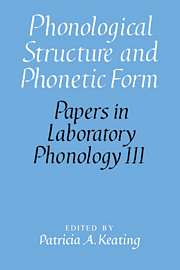Book contents
- Frontmatter
- Contents
- List of contributors
- Acknowledgments
- 1 Introduction
- I Intonation
- II Syllables
- 8 Articulatory phonetic clues to syllable affiliation: gestural characteristics of bilabial stops
- 9 The phonology and phonetics of extrasyllabicity in French
- 10 Phonetic correlates of syllable affiliation
- 11 Syllable structure and word structure: a study of triconsonantal clusters in English
- III Feature Theory
- IV Phonetic Output
- Index of subjects
- Index of names
8 - Articulatory phonetic clues to syllable affiliation: gestural characteristics of bilabial stops
Published online by Cambridge University Press: 26 February 2010
- Frontmatter
- Contents
- List of contributors
- Acknowledgments
- 1 Introduction
- I Intonation
- II Syllables
- 8 Articulatory phonetic clues to syllable affiliation: gestural characteristics of bilabial stops
- 9 The phonology and phonetics of extrasyllabicity in French
- 10 Phonetic correlates of syllable affiliation
- 11 Syllable structure and word structure: a study of triconsonantal clusters in English
- III Feature Theory
- IV Phonetic Output
- Index of subjects
- Index of names
Summary
Introduction
While it is widely assumed that word-initial and word-final consonants are syllable-initial and syllable-final respectively, the syllable affiliation of word-medial intervocalic consonants is less clear. In American English, word-medial intervocalic consonants preceding stressed vowels (as in repáir) are argued to be syllable-initial because they pattern phonologically with syllable-initial consonants: voiceless stops in this position exhibit the aspiration characteristic of word-initial voiceless stops. However, the syllable affiliation of word-medial intervocalic consonants preceding unstressed vowels (as in léper and cáliper) is much debated in the phonological literature. Kahn (1976) argues that these intervocalic consonants are ambisyllabic (they are linked to both the preceding and the following syllable at the same time) while Selkirk (1982) argues that they are simply syllable-final. Since many phonological phenomena in American English appear to be driven by the prosodic affiliation of the segments which undergo them (Kahn 1976), it is important to have an accurate description of the structural representation of the segments. The purpose of this paper is to clarify the nature of consonantal syllable affiliation in American English by providing articulatory phonetic evidence in the form of a comparison of the characteristics of upper-lip movement of consonants whose syllable affiliation is equivocal with consonants with known syllable affiliations (either syllable-initial or syllable-final). Assuming a direct phonology-to-phonetics mapping, intervocalic consonants which precede unstressed vowels are predicted to pattern phonetically with syllable-initial consonants if they are phonologically syllable-initial. Similarly, they should pattern with syllable-final consonants if they are phonologically syllable-final.
- Type
- Chapter
- Information
- Phonological Structure and Phonetic Form , pp. 107 - 135Publisher: Cambridge University PressPrint publication year: 1994
- 5
- Cited by



